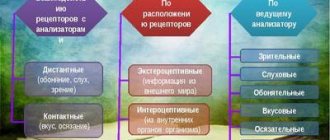Have you noticed that your child reacts strangely to certain sounds, touches, or household procedures?
For example, he is aggressive when approaching him, is afraid to swing on a swing, does not allow his nails to be cut, is frightened by even quiet sounds, and does not accept new food and clothes.
Such phenomena are encountered in the practice of specialists - teachers and psychologists. These “side effects” of behavior are due to the fact that the child has impaired sensory integration - the ability to adequately perceive surrounding phenomena and stimuli. It is on this property that a person’s correct social adaptation and his ability to interact harmoniously with everything around him, including the ability to learn, depend.
How it works?
A huge amount of information enters the brain from the senses. If the nervous system develops normally (the system of transmitting information to the brain, its organization and selection works well), then sensory integration is arranged correctly. This means that the development of the child’s motor skills, speech and behavior is immediate.
If the organs of the nervous system and/or sensory organs are damaged, the process of sensory integration malfunctions: external information is not processed effectively, difficulties arise in mastering everyday skills, feelings and thoughts, the ability to communicate and learn are slowly or insufficiently developed.
You will learn:
- Understand the specifics of behavioral and learning disorders in children from the point of view of maturation of the nervous system.
- To differentiate sensory processing disorders in various forms of dysontogenesis in children (ASD, STD, mental retardation, etc.).
- Independently identify the child’s sensory profile and build a subsequent correction process.
Teacher: Poroshina Elena Aleksandrovna
After completing the program and writing the certification paper, you will receive: A certificate of advanced training for 40 hours. All documents are officially licensed by the Ministry of Education and give the right to conduct psychological practice in current areas of psychology.
Signs of sensory integration disorders
- the child is overly or undersensitive to touch, light, sound or movement
- the child avoids touching certain textures and consistencies: for example, sand, porridge, plasticine
- the child has problems with motor skills: cannot use cutlery, scissors, or writing utensils
- the child has difficulty learning to write, read (particularly misses letters and syllables), ride a bicycle, and follow instructions in general
- the child does not distinguish between right and left sides
- the child is short-tempered, impatient and avoids social contacts
- the child is insufficiently or too physically active, has muscle tone disorders, poor coordination of movements (clumsiness)
- the child has difficulty concentrating, is impulsive, or gets tired easily
- The child has delayed speech and motor development
Comfortable contact with the world
Sensory integration is the ability to put together signals from the senses. Thanks to this process, the baby harmoniously integrates into the world around him and learns about it. Sensory integration has three levels, which are mastered by the child sequentially:
- Bodily sense of self: understanding the position of one's own body (proprioception), the sense of balance and movement (vestibular sensations), and the sense of vibration.
- Vision, hearing and tactile sensations, including smell, taste and touch.
- Higher nervous activity: speech, counting, self-esteem, attention, ability to regulate behavior, creativity.
The child begins mastering the first level even before birth: he feels the movements of the mother’s body, his own movements. The development of sensory integration continues until primary school age.
A correctly mastered basic level provides a reliable foundation for the second. The child grows and becomes able to perceive more data transmitted by the senses. Social behavior is then formed on the basis of sensory integration.
How to help a child with sensory integration disorders?
First of all, try to understand the child: what exactly causes the painful perception of the environment? We will talk about three mutually complementary reasons and their manifestations:
It does not cope with the “requirements” and properties of the environment
He has a weakened, fragile nervous system
Excessive stress
Having understood the cause of the sensory integration disorder, try to reduce the effect of those stimuli that the child does not tolerate well, and “feed” them to him in doses through play. The principle of a functional diet applies here - just not from products, but from games, procedures and activities.
Every day, every person on the planet uses the anatomical and physiological system of their body, incl. sense organs - hearing, vision, taste, smell, touch and vestibular apparatus. It is important to note that each action is first processed by the brain, then the signal is transmitted to the nervous system, which is responsible for performing simple and complex reflexes. Of course, all these processes can be controlled and need to be developed. There is a special direction for this – sensory integration (SI).
Sensory integration: what kind of technique?
Many parents, having heard about SI, ask the question: “Sensory integration - what is it?” We answer and tell you in detail.
Sensory integration (from the Latin “sensus” - sensation, “integratio” - restoration) is a specific process during which the nervous system receives information from the receptors of the sensory organs and, analyzing them, uses them to perform purposeful activities. This is a kind of ability of the nervous system to productively bring together information coming from different channels. The success of a person’s activity as a whole largely depends on how developed this ability is. Therefore, it is important to develop it with the help of special classes on sensory integration. The result of such activities is correct sensorimotor development and instant reflexes to external stimuli.
Conventionally, sensory integration “forces” the brain to perceive information from receptors (and respond to it) faster; accordingly, the processes of reproducing various functions are accelerated.
The possibilities of sensory integration were first described by the American occupational therapist, psychologist and teacher Anne Jean Ayres. She presented the developed methods based on the sensory-integrative approach in 1963 at the University of Southern California as part of her dissertation in educational psychology. Since 1976, Ayres has been exclusively practicing her findings in the field of sensorimotor development, with the help of which she has provided assistance to children with various sensory disorders. Today this method is used all over the world and helps children overcome motor awkwardness and restore the “receptor-reflex” balance.
Who conducts these classes?
Sensory integration is, first of all, work with brain functions, so most often classes using sensory-integrative techniques are conducted by neuropsychologists and defectologists who have undergone additional education in this area. It is possible to say more precisely who will work directly with your child only after diagnostics have been carried out and specific violations have been identified as a result. The program for the restoration and/or development of sensorimotor functions is selected individually; For each child, these are different games and activities aimed directly at the area that is more difficult for him. It is important that the use of sensory integration does not force the child to perform difficult actions; on the contrary, the use of game mechanics is captivating and interesting, and simply affects the same areas of the brain that are responsible for actions that are difficult for a particular child.
Sensory integration disorders in children: examples of such disorders
Sensory integration disorders are called dysfunction and present various problems of auditory, visual, tactile, gustatory, motor, olfactory and coordination. Symptoms of sensory integration dysfunction most often manifest themselves in emotional lability, behavioral factors, motor function, delayed speech development, which subsequently leads to problems in educational activities, social adaptation, concentration and the formation of self-control.
Sensory integration dysfunction is usually complex, i.e. when disturbances manifest themselves in the functioning of several sense organs. However, there is also narrowly targeted dysfunction. What should you pay attention to, and how do sensory integration disorders manifest themselves?
From the auditory function: fear of loud sounds and noise, intolerance to certain types of music or music in general, negative reactions to singing/voice, unresponsiveness to calls, confusion in crowded and public places.
On the part of the visual system: photophobia (preference for twilight and darkness), tension when looking at objects, clumsiness when going up and down (for example, on steps), does not look into the eyes of the interlocutor.
From the tactile function: refraining from playing with plasticine, dough, paints, small objects, reducing pain and temperature sensitivity, do not tolerate being touched. They have a negative reaction to certain types of fabric/clothing; they do not like to walk barefoot.
From the vestibular system: clumsiness and clumsiness of movements, instability, negative manifestations of active games, playgrounds and sports, muscle tone, problems with concentration and coordination, excessive anxiety.
From the taste and olfactory systems: sensitivity to food (refusal of certain types of foods), decreased taste buds, negative reaction to odors, poor sensitivity to odors.
If several disorders from the above symptoms appear, it is necessary to contact a specialist and conduct a diagnosis for sensory dysfunction.
Sensory integration for a child who won't speak
Sensory integration and speech have a very close relationship. Sensory integration dysfunction is one of the common causes of SRD (speech development delay), which is why classes using sensory-integrative techniques are recommended for children who have speech difficulties. Thus, to initiate speech, games aimed at developing fine motor skills are used: busy boards, “dry” pools, games with cereals, sand, etc. In the halls for sensory integration classes, all conditions are created for maximum immersion of the child in an exciting play environment. It is believed that sensory integration is one of the most effective ways to start speech as quickly as possible.
Using sensory integration for ADHD, ASD, autism
Sensory integration disorders arise as a result of the following reasons: — Genetic predisposition — Pathologies of intrauterine development/intrauterine infections — Birth injuries — Pathologies in the newborn/infancy period — Environmental factors (ecology) — Neuropsychological development disorders — Traumatic brain injuries — Cerebral palsy (CP) - Autism spectrum disorder (ASD) - Congenital autism And also as a result of attention deficit hyperactivity disorder (ADHD). It is important that sensory integration dysfunction is almost always detected in autism, ASD, cerebral palsy, and brain damage (for example, traumatic brain injury); often - with ADHD. For ADHD, ASD, cerebral palsy and autism, comprehensive classes with sensory integration are necessary in 100% of cases, because are one of the effective methods for the development of higher mental functions of children with impaired brain activity and damage to the cerebral cortex. For each child, a sensory integration program is developed individually, taking into account the abilities and characteristics of a particular child.
It is worth noting that sensory disorders occur in 20% of all preschool children and require the active introduction of sensory integration into the child’s life.
Where and how are sensory integration classes taught?
Typically, sensory integration classes are conducted by specialists in children's correctional and development centers. A separate room is allocated for this type of activity. The hall is equipped with various game-type objects, interaction with which has a positive effect on the development of brain functions.
What does the sensory room include?
— Various hammocks, mats, balance beams, rocking chairs in different shapes (log, platform, barrel, cube, ball, etc.). — Various types of wall bars, complexes with a sports and gaming focus.
— “Dry” pools, water mattresses and trampolines.
— Rope tunnels and sensory walking paths.
— Trays with various objects for the development of fine motor skills (sand, cereals, balls, etc.).
— Busy boards, busy cubes, busy houses.
— Weighted blankets and pillows.
— rustling objects, bright (of different colors and shapes).
— Educational mats and tables.
— Lighting and sound equipment, etc.
It is unlikely that you will be able to create such a room at home on your own due to the large number of large objects for classes. Moreover, most of the equipment is quite expensive.
How to adjust
Here are several basic types of activity that can be combined depending on the specific manifestation of sensory disintegration.
General recommendations
For advice, contact a specialist from our center. We will provide you with the primary necessary information by calling +7(921) 995-61-57, and at the appointment we will conduct a comprehensive diagnosis and draw up an individual plan for sensory therapy.







